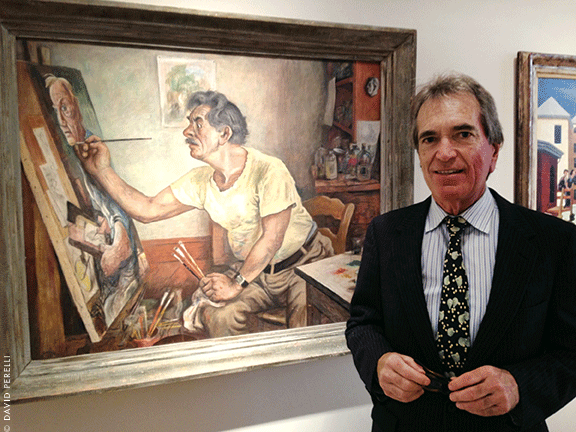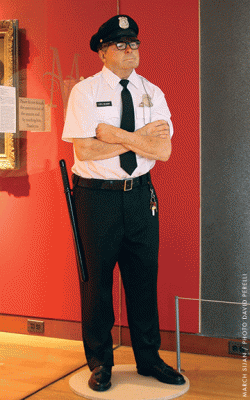
Class of ’70 | It’s been a solid minute’s wait in the lobby of the New Britain Museum of American Art, and the security guard stationed in the corner hasn’t moved at all. Either he’s exceedingly focused on his job or, as you begin to suspect after the second minute, all is not as it appears. Another glance, which registers his suspiciously vintage-looking glasses and uniform, confirms it: he’s not a guard at all but a sculpture of astonishing realism—and, with his dour expression, more than a little humor.

At that moment a trim, middle-aged man in a well-cut suit enters the lobby and, smiling, points towards the guard, a work by the Wisconsin artist Marc Sijan.
“Isn’t he great?” the man says. “I think museums should be fun.” This is director Douglas Hyland C’70, and if there’s one thing he knows how to do very well it’s make museums fun and engaging places to visit.
The city of New Britain, Connecticut, is probably best known as a manufacturing center for the tool and hardware industries. Yet for the last century it has also been home to the institution Hyland directs, which also happens to be the first museum in the country to exhibit only American art. That policy was once a matter of necessity, since even in 1903 the museum’s founding endowment of $25,000 was hardly enough to buy the kind of European works then in vogue. So acting on the advice of the director of the Metropolitan Museum in New York, New Britain went American, and seldom spent more than $1,000 on any given piece. That Yankee thrift—and a keen esthetic—led to a cohesive collection that was far ahead of its time in concept. Today it represents one of the finest of its type.
When Hyland arrived in 1999, he found a sleepy institution with little room to grow. But given the inherent strengths of the collection, he immediately recognized the potential to transform something good into something exceptional. For one thing, he had geography on his side.
“Within a 50-mile radius of this place we have a number of very good highways, and they all converge here,” he explains. “We also have plenty of safe, free parking so it’s very easy for people to pay us a visit. We regularly have visitors from something like 86 zip codes, and last year we had about 100,000 in total coming here from 48 states.”
The roots of Hyland’s career in the arts extend back to his undergraduate years at Penn, where he arrived in the fall of 1967 fresh from a strict New England boarding school.
“I was just thrilled to be on my own, able to feel liberated and stay up all night if I wanted to,” he reminisces. “It was a time of great social unrest in which people were very fervently committed to making the world a better place, and obviously the specter of the Vietnam War loomed. So there were a lot of sit-ins, a lot of political activism.”
But for Hyland it was also a time of intellectual discovery, and he cites three professors in particular who became powerful influences: art historian David Robb, fine-arts professor Robert C. Smith, and art historian John McCoubrey. Because of those three, Hyland decided he would become an art historian. “It was quite a development,” he says, “because my father wanted me to be a lawyer because he was a lawyer himself.”
After earning his PhD in American art history from the University of Delaware and landing a couple of fellowships, a colleague told him that the curator of the Spencer Museum at the University of Kansas had resigned and the post needed filling immediately. Hyland took the job, and a couple of years later became director of the Memphis Museum in Tennessee. Over the next 15 years he served as director of museums in Birmingham, Alabama, and San Antonio, Texas; finally, in 1999, he came back East.
Hyland’s tenure has profoundly transformed the New Britain Museum. One of the first things he did was to embark on an ambitious construction project, the result of which is the stylish masonry-and-glass structure through which visitors today enter.
“Back in the ’30s, ’40s, and ’50s they built these small, unattractive galleries, so what used to be here wasn’t viable,” Hyland explains. “We needed to raise $25 million to start over, and that was really hard.” Thanks to grants from foundations, the state and federal governments, local corporate partners, and private donors, the funds were raised. But that didn’t mean the museum was home free.
“The new building opened up about eight years ago, and we realized that it would be a gamble,” he says. “Would people come? Would people enjoy the events? Would we develop a grassroots support group?”
The answer to these questions was an emphatic yes—to the point where they needed yet another addition, a project that is “in progress right now.”
By making shrewd acquisitions, Hyland has more than quadrupled the size of the museum’s collection since taking over, while at the same time broadening its focus.
“We can’t afford now to buy 19th-century American impressionism, so the idea is that we instead buy contemporary art, art that really speaks of the issues of our day and that will make the museum relevant into the 21st century,” Hyland explains. “So we only buy video art, photography, mixed-media art, contemporary works that are more on the cutting edge of where art is.”
So far this strategy has paid off.
“Hopefully in 20 or 30 years people will say, ‘Wow, wasn’t he smart to buy that Walton Ford, or that photograph by Cindy Sherman,’” he says. “I think I’ve probably bought some duds too, but as they say, you can’t hit the home run every time.”
Hyland has not only recognized emerging talent but also maintained close relationships with established artists, perhaps the most famous of whom was the minimalist Sol LeWitt, a former resident of New Britain and a staunch supporter of the museum.
“He moved here as a child and grew up a few blocks from here on Cedar Street, and he never forgot his hometown,” Hyland says. “So I became friends with him when I arrived, and he gave me advice and encouragement.”
LeWitt was also generous with his work and money. “His whole career, he would make certain things and he would put on the bottom of that work of art ‘for NB,’ for New Britain, because he always felt that loyalty to his hometown,” Hyland said. The artist also financed the construction of a sleek stainless steel, glass, and concrete staircase, over which hangs a work by the glass sculptor Dale Chihuly.
Come October, Hyland will be stepping down.
“I became a director in 1981 and have worked very hard at it, and it’s now someone else’s opportunity,” he says. But a quiet retirement is not necessarily contemplated.
“I would love to work for a foundation somewhere,” Hyland muses. “It would be ideal if instead of always raising money, I could give it away. I would love to say, ‘How can this money be spent most effectively, and how could the long-term impact reach the largest number of people?’”
—David Perrelli C’01

